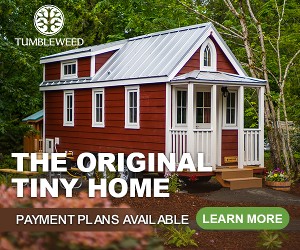1) Have A Budget
A budget defines the process. It is best you get it right else, you risk spending much more than budgeted. Ideally, a tiny house shouldn’t be expensive. The price, however, varies. Factors such as type, size, fittings and materials determine the prices of tiny houses. A tiny house can be of two types; DIY and custom built. The average cost of a well-fitted custom-built tiny house ranges from $150,000 and above.
A DIY tiny house typically costs less. The cost of building could be as low as $10,000, depending on the building plan. However, the average cost of a DIY tiny house ranges between $25,000 to $45,000. If you recruit the service of a professional builder, the cost is about $80,000. Generally, if you wish to keep the cost really low, it is recommended you work with a square footage of 186 ft.²
Basically, a budget is necessary to keep your spending under control. It puts a limit on how much you can spend. Having a building plan is the best way to go about budgeting. A building plan guides you in developing a workable budget. Ideally, before buying or building a house, you should have a clear and vivid picture of how the house should be, the different building materials required and their respective costs. These inputs help you know the expected expenditure. It is also good budgetary practice to make about 10-15% extra allocations to cater for unforeseen expenses. This further buttresses your budget and makes it valid.
2)Select A Great Tiny Home Builder
Dozens of tiny home builders have sprung up over the last few years with all kinds of styles and sizes. We have compiled a non-exhaustive list of our favorites and provided links to their sites:
3) Select A Location
It is imperative to have an exact location in mind before proceeding to build or buy a tiny house. Usually, tiny houses have wheels that allow them to be easily moved around. Those with wheels are usually referred to as recreational vehicles (RVs). Some are constructed on a foundation and are legally tagged accessory dwelling units (ADUs).
Contrary to what is usually portrayed on TV shows and DIY YouTube videos, sitting a tiny house is not simply placing it just anywhere. The wheels don’t necessarily mean you can ride and park it wherever you wish. There are actually county and city restrictions that prevent homeowners from doing this. This means you might be required to locate your RV in an area reserved for RVs. A good example of such is an RV park. So before you purchase that land, it is advisable you consult your local zoning unit. Find more about these regulations here.
Some homeowners prefer to locate theirs on a family compound. There is also the option of renting out parking spots in a community of tiny houses. According to Good Money, a slot can be as low as $250, while purchasing the lot outright costs approximately $65000.
Here’s some advice: Let the location of your tiny house be in close proximity to a hardware store. This makes regular trips to the hardware store less stressful. When you live in a tiny house, these trips become much more regular.
4) Have an Insurance plan
Although it’s a mobile house, you still need to insure it. Tiny houses built on trailers can qualify for RV insurance. A home insurance policy works fine if you intend to park your tiny house on a permanent site. Adventurers wishing to travel the world in their tiny houses should consider a travel trailer insurance policy.
Due to the rising popularity of tiny houses, most insurance providers are beginning to roll out insurance policies that are tailor-made for tiny homes, so you will need to be more proactive whilst navigating this aspect of owning a tiny home. This is necessary in order to get an insurance policy that best suits your tiny house needs.
5) Adjust Your Lifestyle And Keep To The Plan
New tiny homeowners will have to quickly adjust to living in an enclosed space. For some, they take quite a while to get accustomed to this new living space. This sometimes becomes an issue. There is the risk of not keeping to the layout and size. Incorporating a lot of unnecessary features into the building plan defeats the whole essence of a tiny house. That’s why before building or buying a tiny house, it’s important you begin to adjust your lifestyle to conform to living in an enclosed space months before moving in.
A good way to start is by adjusting your daily routine. Basically, changing how you carry out your day-to-day activities. You can consider joining a gym club as a substitute for doing your workouts at home. If you work remotely from home, consider doing so from a local coffee shop. Ditch your home library and use the local library for study. Outsource your laundry duties—use the laundromat instead. You will need to work on your wardrobe. This is one item that takes up a significant amount of space in a tiny house. In preparing to move into a tiny home, you should consider decluttering and downsizing. Make your wardrobe flexible, do more with less. Decluttering and downsizing free up lots of space. These actions significantly reduce the laundry pile. Your wardrobe becomes more functional. No unnecessary clothes, you only have the clothes you need.
The best way to go about this is to have only practical clothing items. Clothing pieces can be combined in different ways and still be unique. Begin to live the minimalist life ahead of your tiny house experience. Maintaining a limited number of colors and patterns makes it easier to combine; you are working with fewer pieces. Another strategy is to plan according to the weather. This means you arrange your clothes according to the seasons. At any point in time, the wardrobe only has clothes suitable for that particular season while the rest are safely stored somewhere else till when needed.
In addition, try out functional furniture. These pieces of furniture help to optimize space. Good examples of these multi-purpose pieces include a bed that doubles as a storage space and a couch that can be folded to serve as a bed.
Here’s some advice: Before drawing up a building plan. Carry out an evaluation exercise in your present home. The test will be carried out in the different rooms present in your home. Before entering a room, have a note stating all activities to be performed in the room as well as the duration. You also do the same for outdoor activities. This will give you a comprehensive list of your daily activities and their corresponding duration. By the end of the week, you will have a clear picture of which rooms are necessary and which ones you can do away with.
In a nutshell, the whole idea of adjusting your lifestyle is to reorientate your mind towards living in a tiny house. These actions make the change less drastic and prevent you from creating extra rooms whilst planning your tiny home—you don’t end up compromising the size with unnecessary features.
6) Have A Building Plan That Suits You
Everyone has their unique needs. What works well for you will be what suits you. Your home is your dwelling place, and it should be a place that is comfortable for you. How the tiny house is going to turn out to be is largely determined by your preferences.
The design should be centered around your way of life and not based on popular trends. It should be how you want it. Ideally, aesthetics shouldn’t be the main focus. Priority should be given to functionality. A good plan is one that accurately answers the question; how can this confined space serve you well? If you are not the cooking type, there is no need to allocate much space for the kitchen area. That space can be channeled to house other functional areas well utilized by you. If you are the type that will rather prefer to stay in bed than come out to sit on the couch in the living room and you spend a large part of your time at home in the bedroom, the building plan that works for you will be one that allocates more space for a large bed and cuts down on the living area.
A living room is not a necessity if you don’t regularly use it. It’s not all about aesthetics but much emphasis on functionality. When you design, make enough allocations to features that are of necessity to you and are very essential in your daily routine.
Want to take a look at some Tiny Home Plans:
Need help with your design but still want to DIY? Check out this program:
Tiny House Made Easy – “How to Build a Tiny House Easily, Cheaply and in Just Days”
7) Be Climate Conscious
This is also very crucial. Your choice of building materials should be appropriate for the climate of the area you decide to locate your tiny house. Windows, roofing and the type of foundation paid should align with the climate of your chosen location. This is to ensure the durability of your home. Avoid using materials that will not fare well against the climate. Generally, heating and cooling account for 40% of household energy. During the building process, when selecting glassware to be used, find out about their specific thermal characteristics. Their thermal properties should be used as criteria for selection. The building materials can significantly cut down energy costs. If the climate is one that is not, you wouldn’t want to use glasswares that generate much heat. The reverse applies if the climate conditions are interchanged. The choice of roofing also matters. In an area where the level of precipitation is high, a better roofing option will be a covering that absorbs and accumulates water. The same applies to areas with high amounts of snow.
Adventurers should factor in the different climate conditions they are likely to encounter as they move about in their tiny homes. Care should be taken to ensure their homes are built to survive in extremes of weather conditions. Also, lightweight building materials and proper weight distribution are highly recommended for tiny homes designed to be transportable. Ensure the RV has adequate rear weight. This prevents it from being tilted sideways whilst being transported.
Most tiny houses are built to be eco-friendly. Most builders utilize recycled materials in order to save costs. It is also a way of being conscious of the environment. Many builders have also come up with several innovative ways to use these recycled materials to create comfortable tiny living spaces.
8) Experience Living In A Tiny House Before Buying One
This is just the basics. You’re not going to purchase an electronic device before first ascertaining it actually works. Same way, you won’t buy a car before first testing it. You ought to know what you are paying for. As a rule of thumb, intending tiny homeowners who wish to purchase pre-built tiny homes should first experience living in one before buying one. Have prior experience of living in a tiny house. Go for a week-long vacation in a tiny house. There are tons of places to go.
Experience the tiny house lifestyle for a few days or a few months.
If you are looking to purchase a pre-built tiny house, You can look up listings on Realtor.com. The least amount you can spend is $25,000, and the maximum is $100,0000 for an outright purchase. These platforms also provide the option to rent.
Here’s some advice: It is best you first rent a tiny house that is similar in size and layout to the one you intend to purchase. A week-long stay should give you enough experience.

